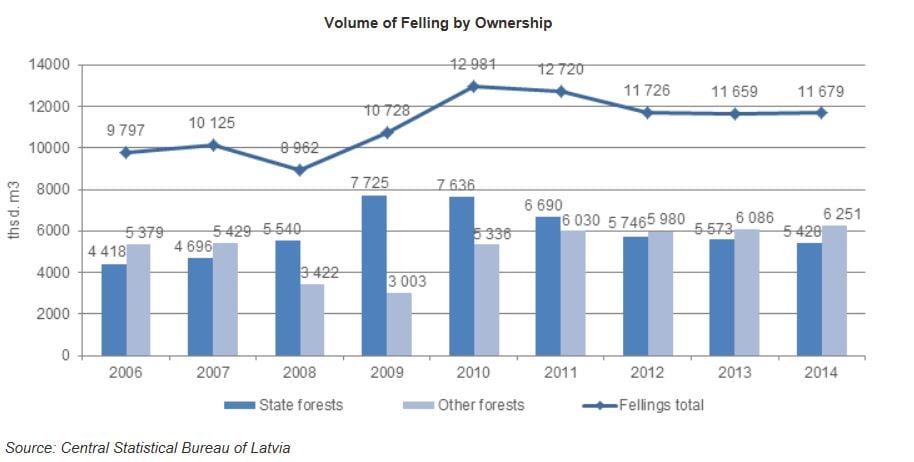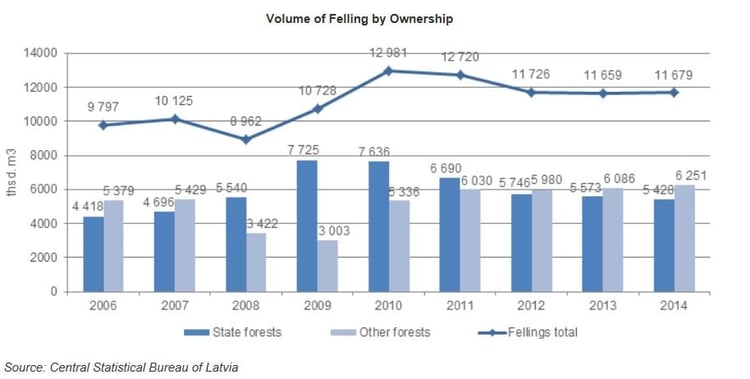2 min read
Latvia’s Vibrant Forest Industry Part I: Timber Supply & Investment
John Greene
:
January 25, 2017

Last month, the USDA’s Foreign Agricultural Service published a detailed report through its Global Agricultural Information Network (GAIN) on the forestry sector and forest products industry in Latvia. As a country with vast acres of dense timberland and a vibrant forest products industry, forestry is a major contributor to the country’s export economy; in 2015 alone, Latvia exported over $2 billion worth of forest industry products. As Scandinavian and Baltic countries continue to competitively access more foreign markets, Latvia’s forest products industry is positioned for growth.
Like many industrial sectors, Latvia’s forest products industry has slowly recovered from the Great Recession of 2008. After a significant decrease in volume in the wake of this crisis, the industry recovered due to competitive improvements and new export opportunities. From 2011 to 2014, relatively fast growth rates were observed in construction and building, which provided steady demand for forest products.
Latvia’s Timber Supply
- Latvia’s forests cover 3.35 million hectares (8.3 million acres), which equates to 52 percent of the country’s territory. Latvia is the fourth most forested country in Europe after Finland, Sweden and Slovenia.
- 54 percent of all trees in Latvian forests are deciduous trees, and they dominate the amount of stock volume. The predominant forest species are:
- Pine: 34.3 percent
- Birch: 30.8 percent
- Spruce: 18 percent
- Grey Alder: 7.4 percent
- Aspen: 5.4 percent
- Black Alder: 3 percent
- The Latvian state owns 49 percent of the forests in the country, and local governments own approximately one percent. The rest of the country’s forests are owned privately by roughly 133,000 independent owners.
- The ownership structure is highly fractured, as 92 percent of these private owners hold less than 20 hectares (50 acres). The average forest property area amounts to 10.6 hectares (26 acres).
- The volume of timber harvested annually from Latvia’s forests up to 2009 was fairly stable, averaging 10-11 million cubic meters. Removals increased in 2010 to the highest level in the past ten years, amounting to almost 13 million cubic meters. In 2013 and 2014, the total volume of timber harvested was 11.7 million cubic meters.

Investments and Trends in the Latvian Forest Products Industry
Latvia has one of the highest investment rates in Europe in the wood and wood products markets due to its vast resources and competitive labor force. Within the wood products subsectors, wood construction has the highest investment rate, although significant investments have also been made in the production of particle board and oriented strand board (OSB).
Per the Ministry of Economy in Latvia, the growth of construction is largely related to public procurements and projects originating from EU funds. Construction volume of both residential and non-residential buildings demonstrated a rapid increase in 2014 (31.1 percent and 34.6 percent respectively). In the non-residential sector, the construction volume of hotels and buildings of similar use experienced the most rapid increase. A moderate increase in the construction of industrial buildings and warehouses was also observed. In the residential sector, construction volume of duplexes experienced the most rapid growth.
However, in the first three quarters of 2015 the volume of building construction was 5.8 percent lower than the year before, primarily driven by a reduction in volume of larger structures (wholesale and retail trade buildings, educational institutions, and administrative buildings).
According to the European Economic Commission, the local Latvian local market for forest products is influenced by a significant increase of solid wood biomass consumption for wood energy production. Wood biomass demand was one of the key forest product market drivers in 2014, and it continued to increase in 2015. In 2014, large-scale heating and new cogeneration CHP plants increased wood consumption to 1,657 million cubic meters. A similar increase in wood biomass consumption has recently been observed in Lithuania and other Baltic countries. Local and regional wood biomass production is impacting the Latvian forest industry, as increasing demand for premium and industrial-grade wood pellets throughout the EU is driving increased pellet production in Latvia.
The next installment on this topic will look at Latvia’s robust forest products export market and import details.





